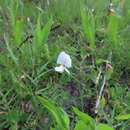Comprehensive Description
provided by North American Flora
Cracca hispidula (Michx) Kuntze, Rev C.en 175. 1891
Catena hispidula Michx. Fl. Bor. Am. 2: 68. 1803. Tephrosia hispidula Pers. Svn. PI. 2: 329. L807. Tephrosia gracilis Nutt. Gen. 2: 119. 1818. Tephrosia elegans Null. Jour. Acad. Phila. 7: 105. 1834.
A perennial, with a fusiform woody root; stem somewhat ligneous at the base, 1-4 dm. long, decumbent, flexuose, branching, angled, sparingly strigose or glabrate; leaves 3-6 cm. long; stipules 2-5 mm. long, subulate, sometimes persistent; petiole 5-15 cm. long; rachis sparingly strigose; leaflets 7-17, elliptic-oblong or lance-oblong, 1-2 cm. long, 4-8 mm. wide, acutish at both ends, those of the lower leaves rounded or even retuse at the apex, apiculate, often reflexed. glabrous or sparingly strigose above, silky-strigose beneath, the veins often reddish; racemes opposite the leaves, lax, 5-10 cm. long; flowers few, 1 or 2 at each node near the end of the peduncle; bracts subulate, 2-5 cm. long; calyx sparingly hairy, the tube 2 mm. long, the lobes lance-subulate, 2 mm. long; corolla purple, 12-16 mm. long; banner roundedobovate; wings broadly obliquely obovate; pod about 4 cm. long, 4-5 mm. wide, slightly falcate (curved downward), 8-12-seeded; seeds dark brown, nearly orbicular, 3 mm. long. Typr locality: "Virginia, Carolina, and Georgia." DISTRIBUTION: Virginia (?); North Carolina to Florida and Louisiana.
- bibliographic citation
- Per Axel Rydberg. 1919. (ROSALES); FABACEAE; PSORALEAE. North American flora. vol 24(1). New York Botanical Garden, New York, NY
Physical Description
provided by USDA PLANTS text
Perennial, Herbs, Stems woody below, or from woody crown or caudex, Taproot present, Nodules present, Stems erect or ascending, Stems or branches arching, spreading or decumbent, Stems less than 1 m tall, Stems solid, Stems or young twigs sparsely to densely hairy, Stem hairs hispid to villous, Leaves alternate, Leaves petiolate, Stipules inconspicuous, absent, or caducous, Stipules setiform, subulate or acicular, Stipules persistent, Stipules free, Leaves compound, Leaves odd pinnate, Leaf or leaflet margins entire, Leaflets opposite, Leaflets 10-many, Leaves hairy on one or both surfaces, Inflorescences racemes, Inflorescence terminal, Inflorescence leaf-opposed, Bracts conspicuously present, Flowers zygomorphic, Calyx 5-lobed, Calyx hairy, Petals separate, Corolla papilionaceous, Petals clawed, Petals ochroleucous, cream colored, Petals red, Banner petal o void or obovate, Banner petal suborbicular, broadly rounded, Wing petals narrow, oblanceolate to oblong, Wing petals auriculate, Wing tips obtuse or rounded, Keel petals auriculate, spurred, or gibbous, Keel tips obtuse or rounded, not beaked, Stamens 9-10, Stamens diadelphous, 9 united, 1 free, Filaments glabrous, Style terete, Style sharply bent, Style hairy, Style hairy on one side only, Fruit a legume, Fruit unilocular, Fruit freely dehiscent, Fruit elongate, straight, Fruit exserted from calyx, Valves twisting or coiling after dehiscence, Fruit beaked, Fruit hairy, Fruit 3-10 seeded, Seeds ovoid to rounded in outline, Seed surface smooth, Seeds olive, brown, or black, Seed surface mottled or patchy.

